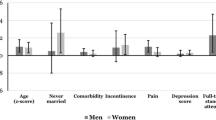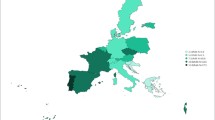Abstract
The objective of the study was to examine the predictive effect of prospectively registered falls on survival within a randomly selected group of elderly women. A longitudinal study, with 9 years follows up after 1 year prospective fall registration was designed. Persons age 75 or more living in the community. A total of 300 Norwegian women; mean age was 80.8 participated in the study. Base-line registrations of health, functioning and medication were made. Falls which occurred during a 1-year period after baseline were registered as well as the date of death within a 9-year period after the end of the fall registration period. Half of the women reported one or more falls (1–11). Eighty-six women (28.7%) experienced only one fall and 65 (21.7%) had at least two. During the 9-year follow-up period, 41.7% died. Cox regression analyzes demonstrated that frequent falling, old age and a self-reported worsening of health were significantly associated with mortality during the follow-up period. Their relative risks of death when experiencing at least two falls was 1.6 (95% CI 1.1–2.4), P = 0.04, when compared with no falls. Older fallers appear to have markedly increased mortality. Since falls are common among elderly people, this is a relevant fact for public health policy. Increasing age, poor self-rated health and high frequency of falls predict independently mortality in our 9 years follow up study. Because women represent the largest proportion of the elderly and falls are amendable, fall preventive may have the potential for significant impact on increasing year of life.

Similar content being viewed by others
References
Gillespie LD, Robertson MC, Gillespie WJ, Lamb SE, Gates S, Cumming RG, Rowe BH. Interventions for preventing falls in older people living in the community. Cochrane Database Syst Rev. 2009;(2):CD007146. doi:10.1002/14651858.CD007146.pub2.
Agüero-Torres H, Thomas VS, Winblad B, Fratiglioni L. The impact of somatic and cognitive disorders on the functional status of the elderly. J Clin Epidemiol. 2002;55(10):1007–12.
Campbell AJ, Borrie MJ, Spears GF, Jackson SL, Brown JS, Fitzgerald JL. Circumstances consequences of falls experienced by a community population 70 years, over during a prospective study. Age Ageing. 1990;19(2):136–41.
Kiel DP, O’Sullivan P, Teno JM, Mor V. Health care utilization and functional status in the aged following a fall. Med Care. 1991;29(3):221–8.
Kosorok MR, Omenn GS, Diehr P, Koepsell TD, Patrick DL. Restricted activity days among older adults. Am J Public Health. 1992;82(9):1263–7.
der Bootsma-van WA, Gussekloo J, De Craen AJ, Van EE, Bloem BR, Westendorp RG. Common chronic diseases and general impairments as determinants of walking disability in the oldest-old population. J Am Geriatr Soc. 2002;50(8):1405–10.
Fry PS, Debats DL. Sources of life strengths as predictors of late-life mortality and survivorship. Int J Aging Hum Dev. 2006;62(4):303–34.
Guralnik JM, Simonsick EM, Ferrucci L, Glynn RJ, Berkman LF, Blazer DG, et al. A short physical performance battery assessing lower extremity function: association with self-reported disability and prediction of mortality and nursing home admission. J Gerontol. 1994;49(2):M85–94.
Laukkanen P, Heikkinen E, Kauppinen M. Muscle strength and mobility as predictors of survival in 75–84-year-old people. Age Ageing. 1995;24(6):468–73.
Murberg TA, Bru E. Social relationships and mortality in patients with congestive heart failure. J Psychosom Res. 2001;51(3):521–7.
Kelly-Hayes M, Jette AM, Wolf PA, D’Agostino RB, Odell PM. Functional limitations and disability among elders in the Framingham study. Am J Public Health. 1992;82(6):841–5.
Frith PA. Impact of smoking, diabetes and hypertension on survival in the elderly: the Dubbo study. Med J Aust. 2005;182(9):495–6.
King MB, Tinetti ME. Falls in community-dwelling older persons. J Am Geriatr Soc. 1995;43(10):1146–54.
Rantanen T. Muscle strength, disability and mortality. Scand J Med Sci Sports. 2003;13(1):3–8.
Center JR, Nguyen TV, Schneider D, Sambrook PN, Eisman JA. Mortality after all major types of osteoporotic fracture in men and women: an observational study. Lancet. 1999;353(9156):878–82.
Forsen L, Sogaard AJ, Meyer HE, Edna T, Kopjar B. Survival after hip fracture: short- and long-term excess mortality according to age and gender. Osteoporos Int. 1999;10(1):73–8.
Bergland A, Jarnlo GB, Laake K. Predictors of falls in the elderly by location. Aging Clin Exp Res. 2003;15(1):43–50.
Hill KD, Schwarz JA, Kalogeropoulos AJ, Gibson SJ. Fear of falling revisited. Arch Phys Med Rehabil. 1996;77(10):1025–9.
Cox E, Tseng DS, Powell I. Trends in falls, poisoning, drowning, and burns Wisconsin: 1986–1996. WMJ. 2001;100(2):39–42.
Horan MA, Clague JE. Injury in the aging: recovery and rehabilitation. Br Med Bull. 1999;55(4):895–909.
Bath PA, Morgan K. Differential risk factor profiles for indoor and outdoor falls in older people living at home in Nottingham, UK. Eur J Epidemiol. 1999;15(1):65–73.
Kannus P, Parkkari J, Koskinen S, Niemi S, Palvanen M, Jarvinen M, et al. Fall-induced injuries and deaths among older adults. JAMA. 1999;281(20):1895–9.
Braekhus A, Laake K, Engedal K. The Mini-Mental State Examination: identifying the most efficient variables for detecting cognitive impairment in the elderly. J Am Geriatr Soc. 1992;40(11):1139–45.
Thorslund M, Norstrom T. The relationship between different survey measures of health in an elderly population. J Appl Gerontol. 1993;12(1):61–70.
Lamb SE, Jorstad-Stein EC, Hauer K, Becker C. Development of a common outcome data set for fall injury prevention trials: the prevention of falls network Europe consensus. J Am Geriatr Soc. 2005;53(9):1618–22.
Cox DR. Regression models and life-tables. J R Stat Soc Ser B Stat Methodol. 1972;34(2):187–220.
Portegijs E, Rantanen T, Sipila S, Laukkanen P, Heikkinen E. Physical activity compensates for increased mortality risk among older people with poor muscle strength. Scand J Med Sci Sports. 2007;17(5):473–9.
Bardage C, Isacson D, Pedersen NL. Self-rated health as a predictor of mortality among persons with cardiovascular disease in Sweden. Scand J Public Health. 2001;29(1):13–22.
Schoenfeld DE, Malmrose LC, Blazer DG, Gold DT, Seeman TE. Self-rated health and mortality in the high-functioning elderly–a closer look at healthy individuals: MacArthur field study of successful aging. J Gerontol. 1994;49(3):M109–15.
Arve S, Savikko N, Lavonius S, Lehtonen A, Isoaho H. Physical functioning, health and survival: a ten-year follow-up study. Aging Clin Exp Res. 2006;18(5):367–73.
Wilson K, Elliott SJ, Eyles JD, Keller-Olaman SJ. Factors affecting change over time in self-reported health. Can J Public Health. 2007;98(2):154–8.
Mossey JM, Shapiro E. Self-rated health: a predictor of mortality among the elderly. Am J Public Health. 1982;72(8):800–8.
Tice JA, Kanaya A, Hue T, Rubin S, Buist DS, Lacroix A, et al. Risk factors for mortality in middle-aged women. Arch Intern Med. 2006;166(22):2469–77.
Author information
Authors and Affiliations
Corresponding author
Rights and permissions
About this article
Cite this article
Sylliaas, H., Idland, G., Sandvik, L. et al. Does mortality of the aged increase with the number of falls? Results from a nine-year follow-up study. Eur J Epidemiol 24, 351–355 (2009). https://doi.org/10.1007/s10654-009-9348-5
Received:
Accepted:
Published:
Issue Date:
DOI: https://doi.org/10.1007/s10654-009-9348-5




